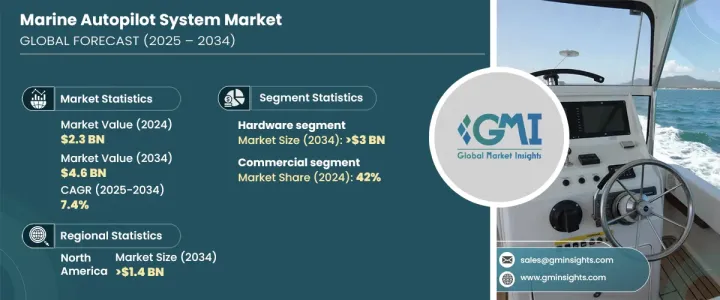
세계의 선박용 오토파일럿 시스템 시장은 급증하고 있으며, 2024년의 평가액은 23억 달러였고, 2025년부터 2034년까지 CAGR 7.4%로 예측되고 있습니다.
자동화는 해양 부문을 변화시키고 효율성, 안전성, 지속가능성을 높이는 고급 자동 조종 시스템을 통해 항해에 혁명을 가져옵니다. 인공지능(AI)과 머신러닝을 탑재한 이 시스템은 항로를 최적화하고, 인적 실수를 줄이고, 운항 정밀도를 향상시키고 있습니다. 기술의 진보가 업계를 계속 형성하고 있는 가운데, 비용 절감과 규제 준수의 강화로 인해, 자율적 및 반자율적인 선박 운항 수요가 높아지고 있습니다.

해운 각사는 운항의 합리화, 연료 소비의 최소화, 배출량의 삭감을 목적으로 자동 조종 시스템의 채용을 늘리고 있습니다. 친환경적인 해운을 강조하는 엄격한 국제 규정으로 인해 자동화는 지속 가능한 목표를 달성하는 데 중요한 요소가 되었습니다. 실시간 데이터 분석과 통합된 AI 주도 자동 조종 시스템은 선박의 정확한 항행을 가능하게 하여 최적의 속도와 연료 효율을 보장합니다. 이러한 진보는 해상 운송을 보다 안전하고 신뢰할 수 있는 것으로 하는 동시에 승무원의 부담을 경감해, 상업, 방위, 레크리에이션의 각 선대에서의 채용 확대에 공헌하고 있습니다.
| 시장 범위 | |
|---|---|
| 시작 연도 | 2024년 |
| 예측 연도 | 2025-2034년 |
| 시작 금액 | 23억 달러 |
| 예측 금액 | 46억 달러 |
| CAGR | 7.4% |
시장은 하드웨어와 소프트웨어 구성요소로 구분되며, 2024년 시장 점유율은 하드웨어가 67%를 차지했습니다. 2034년까지 이 부문은 30억 달러의 수익을 창출할 것으로 예상됩니다. 에너지 효율적인 설계와 컴포넌트의 소형화 개발이 자동 조종 하드웨어의 진화를 촉진하여 고성능 센서와 제어 유닛의 개발로 이어지고 있습니다. 이러한 구성 요소는 전력 소비를 줄이면서 시스템의 정확성과 선박의 조종성을 향상시킵니다. 최신 하드웨어 솔루션은 자이로스코프, GPS 수신기 및 고급 센서를 하나의 컴팩트한 단위로 결합하여 여러 기능을 통합합니다. 이 동향은 오토파일럿 시스템의 효율성과 적응성을 향상시키고 선대의 성능을 극대화하려는 해운 오퍼레이터에게 필수적인 투자가 되고 있습니다. 실시간 데이터 구동 네비게이션에 대한 수요가 증가함에 따라 각 제조업체는 기술 혁신을 계속하고 다른 선상 자동화 시스템과 원활하게 통합 할 수있는 자동 조종 하드웨어를 개발하고 있습니다.
선박 유형별로 보면 2024년 시장은 상업 선박이 42%의 점유율로 압도적인 점유율을 차지했습니다. 민간 부문에서는 GPS, 레이더 및 충돌 회피 시스템과 연결하여 정확한 항행을 보장하는 최첨단 자동 조종 솔루션을 신속하게 통합합니다. 이러한 지능형 시스템은 연료 효율을 높이고, 운항 비용을 줄이고, 인간 오류를 줄여 안전성을 향상시킵니다. 세계의 해운회사는 수익성을 높이고 보다 엄격한 환경규제를 충족시키기 위해 자동화를 우선하고 있으며, 첨단 자동 조종 시스템은 상용선대의 표준 장비가 되고 있습니다. 자율 선박과 무인 선박의 상승은 업계를 더욱 형성하고 있으며, 해운 회사는 화물 운송을 최적화하고 인적 운영자에 대한 의존도를 최소화하는 차세대 기술을 모색하고 있습니다.
북미는 2024년 선박용 자동 조종 시스템 시장의 33%를 차지했으며 2034년에는 14억 달러에 이를 것으로 예측됩니다. 이 지역의 해상 자동화에 대한 강력한 투자는 상업, 레크리에이션 및 방어 응용 분야에 걸쳐 있습니다. 정부의 이니셔티브와 민간 투자는 최신 선대에 자율 기술의 통합을 가속화하고 있습니다. 지속가능하고 비용 효율적인 해운 추진은 지능형 자동 조종 솔루션의 채택을 촉진하고 진화하는 산업 규정을 준수하도록 보장합니다. 방위부문이 자율형 선박에 큰 관심을 보이는 가운데 연구개발 노력은 AI를 탑재한 내비게이션과 제어 시스템의 기술 혁신을 추진하고 있습니다.
The Global Marine Autopilot System Market is experiencing rapid expansion, with a valuation of USD 2.3 billion in 2024 and a projected CAGR of 7.4% between 2025 and 2034. Automation is transforming the maritime sector, revolutionizing navigation with advanced autopilot systems that enhance efficiency, safety, and sustainability. These systems, powered by artificial intelligence (AI) and machine learning, optimize routes, reduce human error, and improve operational accuracy. As technological advancements continue to shape the industry, the demand for autonomous and semi-autonomous vessel operations is rising, fueled by cost reductions and enhanced regulatory compliance.

Maritime companies are increasingly adopting autopilot systems to streamline operations, minimize fuel consumption, and lower emissions. With stringent international regulations emphasizing eco-friendly shipping, automation has become a crucial element for achieving sustainability goals. AI-driven autopilot systems, integrated with real-time data analytics, enable vessels to navigate with precision, ensuring optimal speed and fuel efficiency. These advancements make marine transportation safer and more reliable while reducing the burden on crew members, contributing to increased adoption across commercial, defense, and recreational fleets.
| Market Scope | |
|---|---|
| Start Year | 2024 |
| Forecast Year | 2025-2034 |
| Start Value | $2.3 Billion |
| Forecast Value | $4.6 Billion |
| CAGR | 7.4% |
The market is segmented into hardware and software components, with hardware accounting for 67% of the total market share in 2024. By 2034, this segment is expected to generate USD 3 billion in revenue. Advances in energy-efficient designs and component miniaturization are driving the evolution of autopilot hardware, leading to the development of high-performance sensors and control units. These components enhance system accuracy and vessel maneuverability while reducing power consumption. Modern hardware solutions now integrate multiple functionalities, combining gyroscopes, GPS receivers, and advanced sensors into a single, compact unit. This trend improves the efficiency and adaptability of autopilot systems, making them an essential investment for shipping operators looking to maximize fleet performance. As demand for real-time data-driven navigation grows, manufacturers continue to innovate, creating autopilot hardware that seamlessly integrates with other onboard automation systems.
By vessel type, commercial ships dominated the market in 2024, holding a 42% share. The commercial sector is rapidly integrating cutting-edge autopilot solutions that link with GPS, radar, and collision-avoidance systems to ensure precise navigation. These intelligent systems enhance fuel efficiency, reduce operational costs, and improve safety by mitigating human error. With global shipping companies prioritizing automation to boost profitability and meet stricter environmental regulations, advanced autopilot systems are becoming a standard feature in commercial fleets. The rise of autonomous and unmanned vessels is further shaping the industry, with shipping companies exploring next-generation technologies to optimize cargo transport and minimize reliance on human operators.
North America accounted for 33% of the marine autopilot system market in 2024, with projections reaching USD 1.4 billion by 2034. The region's strong investment in maritime automation spans across commercial, recreational, and defense applications. Government initiatives and private-sector investments are accelerating the integration of autonomous technologies into modern fleets. The push for sustainable and cost-efficient shipping fuels the adoption of intelligent autopilot solutions, ensuring compliance with evolving industry regulations. With the defense sector showing significant interest in autonomous vessels, research and development efforts continue to drive innovation in AI-powered navigation and control systems.